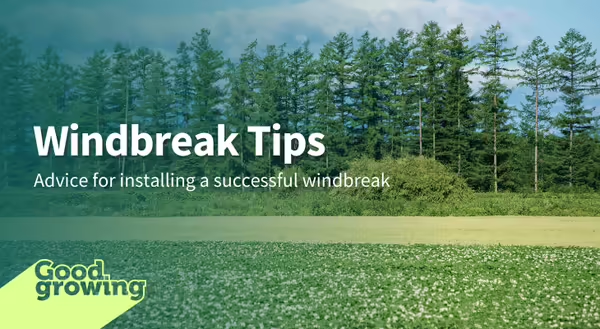
Hold on to your hats! It is windy here in Illinois. Wind can be destructive to our homes and landscapes, plus it can make being outside miserable. This is why many Illinoisians plant windbreaks around their homes to keep that biting wind from causing a drafty house, prevent drifting snow, and make being outside tolerable.
Unfortunately, not all goes as planned with windbreaks. Some of these problems can be avoided with proper planning and choosing plant species suited to your location. Following are some tips for windbreaks.
Windbreak Tips
Space out your plants!
Planting trees too close may be the biggest problem with windbreaks that I see. Homeowners need to account for the mature size of the trees when designing the windbreak. Trees that are planted too close, grow and shade out lower limbs, which eventually fall off. Over time the trees may still be alive, but without lower limbs, the windbreak is not functional.
Remove the rootball wrapping
Often windbreak trees are larger and come as balled-and-burlapped. The burlap and wire cage help to keep the rootball intact during transportation and carrying the tree to the planting hole. Once you’re ready to plant the tree, the wrapping can be removed so it is not a barrier to the root system.
Don’t plant too deep
Anymore it can almost be assured your tree will have too much soil on top of the rootball at the time of purchase. Carefully remove soil from the top of the rootball until you encounter the first structural root or root flare. Cut off any circling roots while you’re at it!
It doesn’t have to be uniform
Most windbreaks consist of a single row of identical evergreens. A common problem is when a plant disease specific to that species makes its way through the windbreak and suddenly, your windbreak is dead.
It doesn’t have to be all evergreen
Perhaps some of the best windbreaks I have observed have had a diversity of evergreens, deciduous shade trees, small trees, and shrubs. If you have the space, consider having multiple rows of different types of plants.
Too dense?
Ideally, a windbreak will still allow for some airflow for uniform snow dispersal and create a larger envelope of protection. The more air that is pushed up, the faster it comes down. Shrinking the area of protection.
Setback from ag fields
Set the windbreak back from agricultural fields. Most windbreaks I visit are next to massive corn or soybean fields. To grow these crops farmers spray herbicides. Don’t plant your tree in harm’s way. Leave a 30-foot buffer between the tree and farm field.
There are a lot more considerations when it comes to windbreaks such as how tall should the tree be? How far out should it extend? What species work best in Illinois? Check out the following resources for more help in building your windbreak:
This Windbreak Design publication from Nebraska Extension dives into the details, including height, width, and how long the windbreak should be. Plus, how far away should the windbreak be from the house?
Wondering about recommended windbreak plant species for Illinois? Check out this document from the University of Illinois Plant Clinic The Thin Green Line
Good Growing Tip of the Week: Want a more immediate windbreak? You could try to plant trees closer together and thin out every other as they grow. Sometimes we have a tough time cutting down perfectly healthy trees. Be sure you can make that commitment.
During this recorded webinar retired Extension educator Dave Shiley will teach you how to maximize your windbreak investment.
Signup for our emails!
Want to get notified when new Good Growing posts are available? SIGN ME UP
MEET THE AUTHOR
Chris Enroth is a horticulture educator with University of Illinois Extension, serving Henderson, McDonough, Knox, and Warren counties since 2012. Chris provides horticulture programming with an emphasis on the home gardener, landscape maintenance personnel, and commercial landscapers. Additional responsibilities include coordinating local county Master Gardener and Master Naturalist volunteers - providing their training, continuing education, advanced training, seasonal events, and organizing community outreach programs for horticulture and conservation assistance/education. In his spare time, Chris enjoys the outdoors, lounging in the garden among the flowers (weeds to most).